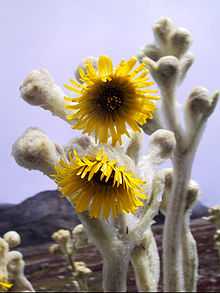Espeletia
| Espeletia | |
|---|---|
 | |
| Espeletia in Páramo de Guerrero (Colombia) | |
| Scientific classification | |
| Kingdom: | Plantae |
| (unranked): | Angiosperms |
| (unranked): | Eudicots |
| (unranked): | Asterids |
| Order: | Asterales |
| Family: | Asteraceae |
| Genus: | Espeletia Mutis ex Humb. & Bonpl. |
| Species | |
|
See text | |
Espeletia, commonly known as Frailejón or Fraylejón is a genus of perennial subshrubs, in the family Asteraceae. The genus, which is endemic mainly to Colombia, Venezuela and Ecuador, was first formally described by botanist Alexander Von Humboldt in 1801. The genus was named after the New Granada viceroy José Manuel de Ezpeleta.

There are about 88 species in this genus, some of which are native to Colombia. The plants live at high altitude in the Páramo ecosystems. The trunk is thick, with succulent hairy leaves disposed in a dense spiral pattern. Marcescent leaves help protect the plants from cold. The flowers are usually yellow, similar to daisies.
The status of conservation of the Frailejon plant is endangered due to destruction of the páramo for agricultural purposes, especially potato crops. This activity continues, despite the fact that it was declared illegal by the Colombian government.
Species include:



- Espeletia grandiflora Humb&Bonpl.
- Espeletia killipii Cuatrec.
- Espeletia uribei Cuatrec.
- Espeletia pycnophylla Cuatrec.
- Espeletia schultzii (Benth.) W.M.Curtis
- Espeletia curialensis
References
- "Espeletia Humb&Bonpl.". Australian Plant Name Index (APNI), IBIS database. Centre for Plant Biodiversity Research, Australian Government.
External links
| Wikimedia Commons has media related to Espeletia. |